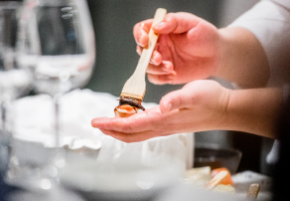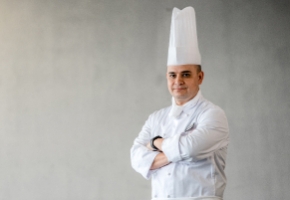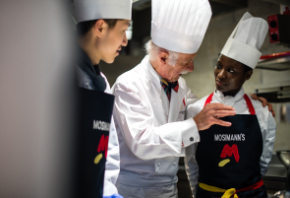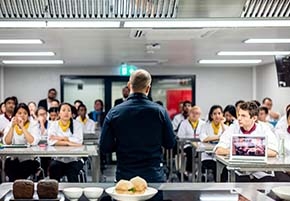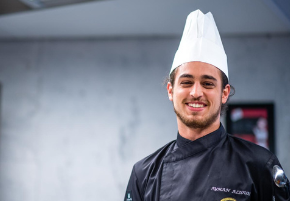- About
- Programs
- Campus Life
- Career Services
- Admissions
- News & Events
- Alumni
How to Grill: The Beginner’s Guide to Perfect BBQ
Learn how to grill like a pro with easy tips, techniques, and safety advice. Perfect for beginners who want delicious results every time.
Key Takeaways
- Essential grilling equipment include a sturdy grill, quality tongs, a meat thermometer, and a grill brush.
- Key grilling techniques involve mastering direct and indirect heat, controlling temperature, and resting food after cooking.
- Safe grilling means keeping raw and cooked foods separate, monitoring flames, and constantly checking internal temperatures.
Summer gatherings and outdoor celebrations are usually accompanied by the sizzle of food on the grill. Grilling brings people together through the shared experience of cooking and enjoying delicious food outdoors.
Grilling is a versatile cooking technique that transforms various simple ingredients into restaurant-quality dishes. Knowing how to grill properly elevates the natural flavors of food while creating that distinctive smoky taste that can't be replicated indoors.
Essential Grilling Equipment
In many styles of cooking, success depends mainly on ingredients and technique. A skilled cook with fresh produce can often achieve great results with even the simplest setup. Grilling, however, is a bit different. With this technique, equipment plays as big a role as the cook's knowledge.
The centerpiece is, of course, the grill itself. While there are countless variations on the market, most people choose between gas or charcoal models.
Gas grills are often the first choice for those who value ease and consistency. Such grills ignite with the push of a button and can reach cooking temperature in minutes as well as hold that heat steady throughout the session. It's a great option if you want to concentrate on cooking without worrying about fire control.
Charcoal grills demand a little more patience and practice, but reward you with that unmistakable smoky depth of flavor. The smoke from woods like mesquite can infuse food with rich aromas that gas grills can’t replicate. They can reach higher temperatures than gas, which is why many people swear by them for searing steaks or achieving crisp, flavorful crusts. Controlling the fire, by adjusting vents or arranging coals, is considered by many as part of the craft itself.
Some other must-have tools for grilling include:
- Long-handled tongs for safely turning food without piercing meat and losing juices
- Grill brush to keep grates clean and prevent sticking, improving both flavor and food safety
- A meat thermometer to guarantee that food reaches safe internal temperatures while staying tender
- Skewers or grill baskets for cooking smaller cuts, vegetables, or delicate items with ease
- Heat-resistant gloves and grill mats to protect hands and provide flexibility when working over high heat
Professional-grade equipment may feel like an investment, but it consistently pays off in results and safety. At Culinary Arts Academy Switzerland, we teach students early on that tools are an extension of their skills. To reinforce this, every student receives a professional tool kit when they join our programs—a reminder that great cooking is as much about passion and technique as it is about respecting the equipment that makes excellence possible.
How to Prepare the Grill
Before food ever touches the grates, the grill itself needs proper preparation. This step is often overlooked, especially by beginners, yet it's what decides whether you'll be cutting steak that's evenly cooked and juicy, or slicing into meat, fish, or vegetables that turn out uneven and disappointing.
To properly prepare the grill, start with a thorough cleaning. A clean grill prevents old residue from sticking to fresh food and keeps flavors pure. Use a grill brush to remove leftover debris, then wipe down the grates with a damp cloth. For gas grills, check whether burners are free of blockages and gas lines are secure.
Start Your Culinary Journey
Learn the art of cooking in a world-class environment
Preheating is just as important, especially when it comes to searing and reducing sticking. Gas grills usually need 10–15 minutes to reach the right temperature, while charcoal requires 20–30 minutes. As a guide, high heat runs between 450–650°F, medium-high between 375–450°F, and medium between 300–375°F.
The final step is oiling the grates. This creates a thin protective layer that fills in tiny surface pores on the metal, making it harder for food to cling. Dip a folded paper towel into high-heat oil, grip it with tongs, and carefully rub it across the hot grates. This way, even delicate foods like fish or vegetables release cleanly instead of tearing apart.
Key Grilling Techniques
The approach you take and the techniques you use depend entirely on what's on the grill. You wouldn't cook a steak the same way you'd handle delicate vegetables, and understanding those differences is what makes the results stand out.
The foundation of grilling technique lies in how you use heat. Direct heat grilling places food directly over the flames or coals and is best for foods that cook in 30 minutes or less. This high-heat method is what creates deep sears, caramelized grill marks, and flavorful crusts. Think steaks, burgers, chops, smash burgers, or even vegetables like peppers and zucchini.
Indirect heat grilling mimics the effect of roasting. Food cooks next to the heat source, not directly over it. This technique allows larger cuts, like roasts or whole chickens, to cook evenly without burning. Many chefs combine both, starting with direct heat for a rich sear, then finishing with indirect heat to ensure the inside is cooked through.
Heat management is where professionals set themselves apart. Keeping a grill between 225–300°F for smoking requires steady attention, but the payoff is tender meat that's evenly cooked all the way through. Controlled temperatures prevent the all-too-common mistake of burning the outside while leaving the inside underdone.
Another mark of skill is knowing when to leave food alone. Constant flipping or moving prevents proper searing and disrupts flavor development. Most foods should only be flipped once, and a simple trick is to wait until they naturally release from the grates. That's the grill telling you it's time.
How to Grill Different Types of Food
The way you handle fire, timing, and placement on the grill depends entirely on what's cooking. To truly command the grill, you need to master grilling the following types of food and understand how each one cooks best.
Meats (steak, chicken, burgers)
Grilling meat is where precision matters most, particularly in terms of timing and food safety. Preheating the grill thoroughly is non-negotiable, as without it, you miss the sear that locks in juices and creates the Maillard reaction. This chemical process is what develops the brown crust and deep, savory flavor that defines a well-grilled steak.
Seasoning also works differently here. Salt, pepper, rubs, or marinades should be applied in advance to penetrate the meat, but always refrigerate when marinating for safety. Thicker cuts benefit from a two-zone method: sear over high heat, then finish on indirect heat until they reach safe internal temperatures (145°F for steaks and chops with a rest, 160°F for ground meat, and 165°F for poultry).
Seafood
Fish and shellfish take nearly the opposite approach. Where meat can handle high heat and longer cooking, seafood demands delicacy and speed. When cooking this type of food, start with a clean, oiled grate because fish lacks the structure of steak, so sticking is your biggest enemy. Brush lightly with oil, season simply, and cook over medium heat to protect delicate flesh.
The internal temperature targets are much lower: 145°F for fish (until opaque and flaky) and 120°F for shrimp. Unlike meat, which often needs flipping and repositioning, seafood should only be turned once to avoid breakage. Remove from the grill the moment it's done, and carryover heat will take care of the rest, just as with thicker meat cuts.
Vegetables
Vegetables fall somewhere between meat and seafood in their demands. They need the steady heat and structure of meat, but the light handling of seafood. Cutting them into even sizes guarantees consistency across every bite. Brushing with oil before grilling prevents sticking and helps develop color, much like the sear on steak.
When grilling small pieces of vegetables, it's helpful to use the support of grill baskets or skewers in order to keep them from slipping through the grates. Cook over medium-high heat until tender yet crisp, flipping once to preserve grill marks.
Grilling Safety Tips
The high heat used in grills creates conditions where small mistakes can quickly become dangerous. That is why the following safety practices represent the essentials every griller should master:
- Hand and utensil hygiene: Wash hands thoroughly before and after cooking with raw meat, poultry, or seafood. Always use separate plates and tools for raw and cooked foods to prevent cross-contamination.
- Temperature control: Keep raw ingredients chilled until grilling, maintaining storage at or below 40°F. This prevents harmful bacterial growth during preparation and transport.
- Managing flames safely: Keep a spray bottle of water close to handle flare-ups. For gas grills, inspect lines regularly for leaks to avoid hazardous situations.
- Proper ash disposal: Only discard charcoal ashes once they are completely cool, as embers can remain a fire risk for hours after cooking.
Common Grilling Mistakes to Avoid
Even seasoned cooks make grilling mistakes that affect flavor, texture, consistency, and overall safety. Learning what those errors are and how to avoid them can bring you closer to the level of precision taught in professional culinary degree programs.
The most common grilling mistakes you should avoid are:
- Overcrowding the grill, causing food to steam instead of sear
- Cooking everything on high heat, leaving burnt exteriors and raw interiors
- Lifting the lid too often, dropping the temperature and delaying cooking
- Using too much lighter fluid, leaving food with chemical flavors
- Not preheating the grill, preventing proper searing and caramelization
- Flipping meat too frequently, disrupting crust formation
- Applying sauce too early, burning the sugars
- Skipping rest time, leaving meat dry instead of juicy
- Using dirty grates, sticking food and adding bitter residue
- Cutting meat immediately, causing juices to escape
- Cross-contaminating raw and cooked foods, compromising food safety
Mastering the Grill
Grilling expertise comes from patience and practice, along with careful attention to heat, timing, and safe handling of food. These skills, when combined with quality ingredients and proper equipment, enable you to create the best dishes.
However, true culinary growth happens when you step beyond familiar methods. Grilling may be where you start, but professional training also introduces you to roasting, sous vide, pastry, and even molecular techniques.
At Culinary Arts Academy Switzerland, our BA in Culinary Arts program combines practical training with business education. This way, we help equip you with the skills to excel as a chef and the entrepreneurial insight to launch your own venture.
Cooking well comes with practice, but becoming a professional chef requires the depth of knowledge and discipline that education provides.
Frequently Asked Questions
What’s the difference between grilling and barbecuing?
Grilling uses direct high heat for quick cooking, while barbecuing uses indirect low heat for extended periods, often with smoke for flavor.
Do you need to close the grill lid while cooking?
Yes, for most items, closing the lid maintains a consistent temperature and creates an oven-like environment for even cooking.
How often should you clean your grill grates?
Clean grates after every use while they're still warm, and perform deep cleaning monthly for optimal performance and food safety.
Interested in becoming a world-class chef? Learn more about Culinary Arts Academy Switzerland. Download our brochure.


